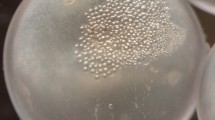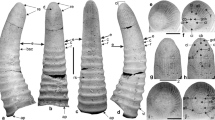Abstract
External skin brooding evolved independently in several groups of fishes. Cotylephores, sites for the attachment of developing embryos, occur within the fused pelvic fins of the ghost pipefishes, Solenostomus, on the ventral surface of the South American catfish, Platystacus, and on other aspredinid cattfishes of the tribe Aspredini. Cotylephores are transient outgrowths of tissue that occur only on brooding fish. They consist of a pedicle that extends from the abdomen or fin and terminates in an apical calyx. The calyx supports and adheres to the egg envelope that encloses the developing embryo. The pedicle of the catfish cotylephore is a single, large structure (1615 ± 23.25 µm), while those of ghost pipefishes are small and branched (687 ± 3.89 µm; number of branches: 26 ± 0.63). In both instances, a simple cuboidal epithelium, whose cells bear microplicae, encloses an extensive connective tissue core that contains large blood vessels that ramify into a capillary plexus in the calyx. Cotylephores of Platystacus are more heavily vascularized than those of Solenostomus and contain 34.77% more blood vessel surface area at the calyx, to which the egg envelope adheres. In addition to their role in attachment, cotylephores may function in embryonic maintenance through the exchange of gas across the egg envelope, mediated by female circulatory vessels within the cotylephore calyx. Comparisons of morphology and development suggest that cotylephores are the result of convergent evolution of a reproductive adaptation.
Similar content being viewed by others
References cited
Armstrong, P.B. & J.S. Child. 1962. Stages in the development of Ictalurus nebulosus. Syracuse University Press, New York. 24 pp.
Balon, E.K. 1975. Reproductive guilds of fishes: a proposal and definition. J. Fish. Res. Board Can. 32: 821–864.
Balon, E.K. 1981. Additions and amendments to the classification of reproductive styles in fishes. Env. Biol. Fish. 6: 377–389.
Bloch, M.E. 1794. Naturgeschichte der auslandische Fische. Achter Theil. J. Moreno & Co., Berlin. 486 pp.
Breder, C.M. Jr. & D.E. Rosen. 1966. Modes of reproduction in fishes. Natural History Press, Garden City. 941 pp.
Burgess, W.E. 1989. An atlas of freshwater and marine catfishes: a preliminary survey of the Siluriformes. TFH Publications, Neptune City. 784 pp.
Clutton-Brock, T.H. 1991. The evolution of parental care. Princeton University Press, New Jersey. 352 pp.
Cuvier, G.L.C.F.D. & A. Valenciennes. 1840. Histoire naturelle des poissons. Vol. 15. Charles Pitois, Paris. 449 pp.
Dawson, C.E. 1985. Indo-Pacific pipefishes. Gulf Coast Research Laboratory, Ocean Springs. 230 pp.
Friel, J.P. 1994. A phylogenetic study of the neotropical banjo catfishes (Teleostei: Siluriformes: Aspredinidae). Ph.D. Thesis, Duke University, Raleigh. 256 pp.
Friel, J.P. & J.G. Lundberg. 1996. Micromyzon akamai, gen. et sp. nov., a small and eyeless banjo catfish (Siluriformes: Aspredinidae) from the river channels of the lower Amazon basin. Copeia 1996: 641–648.
Ghiselin, M. 1994. The origin of vertebrates and the principle of succession of functions: genealogical sketches by Anton Dohrn 1875. Hist. Phil. Life Sci. 16: 32–96.
Green, J. 1858. On the habits of Aspredo. Proc. Boston Soc. Nat. Hist. 4: 328.
Günther, A.C.L.G. 1880. An introduction to the study of fishes. Adam and Charles Black Publ., Edinburgh. 720 pp.
Liem, K.F. 1981. Larvae of air-breathing fishes as countercurrent flow devices in hypoxic environments. Science 211: 1177–1179.
Myers, G. 1960. The genera and ecological geography of the south american banjo catfishes, family Aspredinidae. Stanford Ichthyological Bulletin 7: 132–139.
Sands, D.D. 1984. Catfishes of the world, vol. 4, Aspredinidae, Doradidae & Loricariidae. Dunrue Publ., Dunrue. 281 pp.
Satchell, G.H. 1991. Physiology and form of fish circulation. Cambridge University Press, Cambridge, 235 pp.
Wetzel, J., J.P. Wourms & S.G. Poss. 1992. Cotylephores of the ghost pipefish: sites of egg attachment and maternal-embryonic exchange. Amer. Zool. 32: 154A.
Wetzel, J. & J.P. Wourms. 1995. Adaptations for reproduction and development in the skin-brooding ghost pipefish, Solenostomus. Env. Biol. Fish. 44: 363–384.
Whitear, M. 1986. The skin of fishes including cyclostomes: epidermis; dermis. pp. 8–65. In: J. Bereiter-Hahn, A.G. Matoltsky & K.S. Richards (ed.) Biology of the Integument, vol. 2, Springer-Verlag, Berlin.
Wourms, J.P. & J. Wetzel. 1992. Evolutionary morphology of cotylephores: egg attachment sites in skin-brooding fishes. Amer. Zool. 32: 160A.
Wyman, J. 1859. On some unusual modes of gestation. Amer. J. Sci. 77: 5–13.
Author information
Authors and Affiliations
Rights and permissions
About this article
Cite this article
Wetzel, J., Wourms, J.P. & Friel, J. Comparative morphology of cotylephores in Platystacus and Solenostomus: modifications of the integument for egg attachment in skin-brooding fishes. Environmental Biology of Fishes 50, 13–25 (1997). https://doi.org/10.1023/A:1007309526982
Issue Date:
DOI: https://doi.org/10.1023/A:1007309526982




